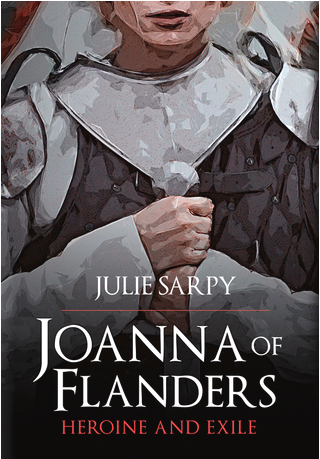Joanna of Flanders: Heroine and Exile by Julie Sarpy
Review by Sandra Alvarez
Joanna of Flanders (1295–1374) is a contentious figure, a woman whose legacy has been debated by scholars for centuries. Considered a heroine by many – a strong, unyielding woman who saved her beloved Brittany from the clutches of Norman occupation at Hennebont – Joanna met a rather sad and ignominious end imprisoned in Tickhill Castle for the better part of 30 years until her death in 1374.
Julie Sarpy’s book challenges the status quo by re-examining the themes and controversies in Joanna’s life that led to her confinement, and the dated scholarship of the past that cemented her reputation as a mentally ill and unstable woman.
Sarpy’s book explores Joanna’s background, touching on public records, folklore, statuettes, and myriad sources to provide an in-depth, cohesive picture of Joanna’s life. She discusses several primary sources; chroniclers such as Jean Froissart (1337–1405), Adam Murimuth (1274/75–1347) and the Latino chronicle of French kings: Chronographia regum Francorum (1405–29) to explore how contemporary sources treated Joanna.
Sarpy makes this more than just another typical biography by tackling the discourse around mental illness in the Middle Ages and by comparing Joanna’s situation with that of other prominent cases of confinement such as Eleanor of Aquitaine (1122–1204) , Robert Curthose (1051–1134), and Elizabeth de Burgh (1284–1327) – second wife of Robert the Bruce (1274–1329). What is particularly interesting about her findings is the discrepancy in the treatment of men vs. women; for example, Eleanor was imprisoned for joining in the coup with her sons against Henry II, yet her sons were not. Another instance of this gender disparity was in the treatment of men with bizarre behaviour, such as Charles VI of France (1368–1422). Charles’ bouts of insanity were well documented; even after he slew his brother and four knights in 1392 in a fit of madness, concessions were made for him that were not made for Joanna (or for any other woman, for that matter). According to Sarpy, ‘Joanna of Flanders’ display of emotions, if there were any, became politicized, associated with irrationality, and became a liability.’
The most compelling part of the book dealt with the legalities surrounding the determination of mental competence, and the process of confinement due to mental illness. The legal precedent for confinement stemmed from the fifth century Law of Twelve Tables; which formed the foundation of Roman Law. Womanhood and mental incompetency fell under the same umbrella, with women requiring male supervision, even after having reach the age of majority. The book also looked at the rules behind medieval legal guardianship and explored the idea that sanity in the Middle Ages was tied to memory, i.e. if the person could remember their name, their parents’ names, and where they came from, they were showing sound mind. These "idiocy inquisitions" were conducted by government officials and only on people with wealth. Sarpy noted that ‘non-fief holders garnered no profit for the king so he wasn’t interested in those cases’. What is important in her examination of this point, and Joanna’s case, is that overwhelmingly, evidence points to the fact that one could not alienate or property land, or impose guardianship without a test for competency. Sarpy discovered Joanna’s competency inquisition was been omitted from the records. All such proceedings had to be recorded, certified, and sent to Westminster within one month. For someone of Joanna’s high status - there would have definitely been a record made, yet in 361 cases between 1200-1500, no inquisition occurred, and no evidence in the records of a medical determination of sanity. This makes her ‘mental breakdown’ and questions surrounding her mental health dubious at best.
The book also devotes time to recount the difficulties inherent in determining mental fitness. Sarpy suggests that because medieval texts are highly stylized and conform to the social conventions of the time, that they are selective in what they want to portray, making it tricky for historians to filter fact from fiction. The book then then proceeds to tackle the problems with early impressions of Joanna. Historians were lured into believing she went mad but, Sarpy argues, they present no evidence as such – no explanation. They have hinged their suppositions on the nineteenth century scholarship of Arthur Le Moyne de la Borderie (1827–1901) who put forth the idea that Joanna suffered an emotional collapse. La Borderie - in typical nineteenth century fashion, blamed Joanna’s breakdown on the ‘weakness of the the female mind’. Sarpy demonstrates convincingly that his take is full of the cultural biases of his time, yet his scholarship has remained relatively unchallenged.
So why was Joanna really confined if it wasn’t because she was mentally unfit? Sarpy believes that Joanna’s incarceration was due to her being a powerful female who presented a threat to the crown and therefore, must be controlled. She details the history behind the Honour of Richmond and suggests some of the reasons Edward III (1312–1377) had for imprisoning her. The land was granted to his son, John of Gaunt (1340–1399), Edward never really intended to invest Joanna’s husband, John de Montfort (1295–1345) with this earldom. It was always intended for use by Gaunt because Richmond was a lucrative and prestigious possession, and had been since the time of William the Conqueror (1028–1087).
Edward’s biggest fear was the potential of Joanna being reunited with her husband after his release from the Louvre in September 1341. Together, they may have mounted a challenge to John of Gaunt’s investment as heir of Richmond. They also posed a threat due to their sovereignty over Brittany. Edward surmised that if Joanna was out of the way, he could do whatever he wanted with impunity. Brittany was important to Edward, and he could not risk Joanna challenging him for it by potentially joining forces with the French.
Joanna of Flanders: Heroine and Exile is an attempt to rehabilitate not only Joanna, but to shine a light on the ways in which powerful women who posed a threat were "managed" under the dubious auspices of ‘mental illness’. Sarpy challenges the black mark left on Joanna’s legacy by eighteenth and nineteenth century scholars, who propagated the idea that Joanna was suffering from ‘hysteria’, a condition at that time associated with women due to their being considered ‘the weaker sex’. Sarpy shows the step-by-step process for ascertaining mental incapacity and forcible confinement. She also highlights the glaring biases in the treatment of men and women who were deemed mentally unfit. Sarpy manages to convincingly demonstrate that in the case of Joanna of Flanders, records were purposely omitted and proper channels were circumvented to allow Edward III to remove Joanna to further his own agenda. Joanna of Flanders was mentally competent and was imprisoned solely due to her potential threat to the Edward’s political agenda. This book offers a fresh take on a controversial, and important medieval figure. It is a invaluable addition to anyone studying disability, imprisonment, or women and power structures in the late Middle Ages.
Joanna of Flanders: Heroine and Exile
Author: Julie Sarpy
Publisher: Amberley Publishing
ISBN-13: 978-1445688541

